LG Electronics USA DT-NK PERSONAL COMPUTER User Manual 4E4B5FC7A5C1F62E717864
LG Electronics USA PERSONAL COMPUTER 4E4B5FC7A5C1F62E717864
Contents
- 1. USERS MANUAL 1
- 2. USERS MANUAL 2
- 3. USERS MANUAL 3
- 4. USERS MANUAL 4
USERS MANUAL 3
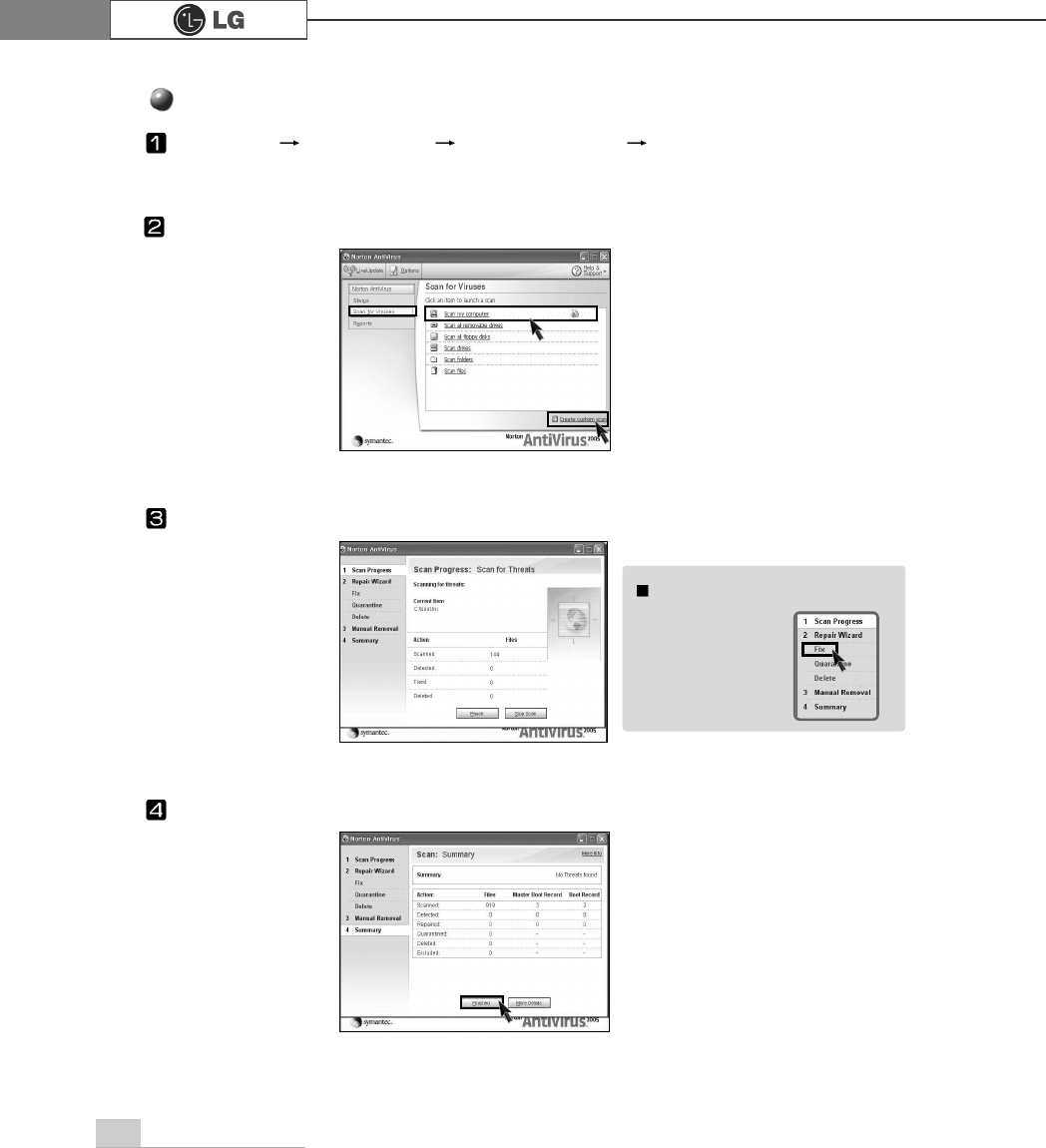
46 Using the system
Click [Start] [All programs] [Norton Antivirus] [Norton AntiVirus2005].
Click [Scan for virus] and select an item to scan.
Norton AntiVirus is scanning virus.
Click [Finish]. Virus scanning is complete.
Running Norton Antivirus
If any virus is detected, click
[Fix] to repair.
Note

47MEMO
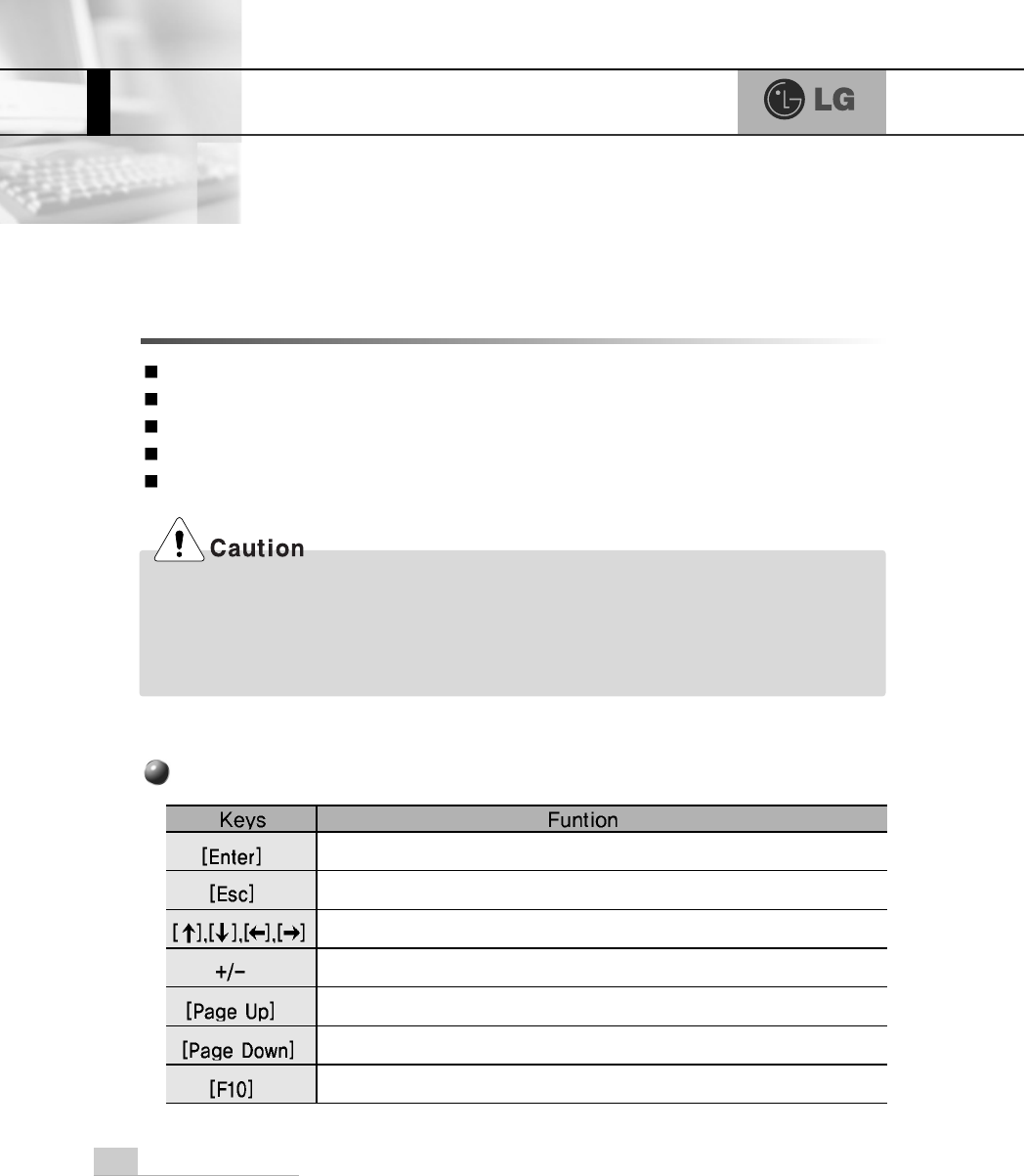
System setup
48
System setup means storing hardware configuration information of the computer in
CMOS RAM. Through the System Setup, the computer gets various information -date
of the day, time, memory capacity, H/D capacity and its type.
System Setup is to set passwords, to change booting orders, and to add new periph-
eral devices.
3-1. Entering System Setup
Booting with a USB drive (Page 50).
Setting a password (Page 52).
Deleting or changing a password (Page 53).
Initializing system setup (Page 55).
Deciding the temporary booting orders (Page 56).
Select the current item.
Closes the current task or goes back to the previous screen.
Moves up, down, right, and left.
Increases or decreases the item values.
Goes to the beginning of the screen.
Goes to the end of the screen.
Saves changes and exits System Setup.
Keys Used in System Setup
3. System setup
Wrong system setup may cause errors during system operation. Therefore, be careful
when changing the System Setup, and it is recommended not to change the setup unless it
is necessary.
For performance improvement, CMOS setup menu configuration and the initial setup status
may be changed and may become different from images included in the user manual.
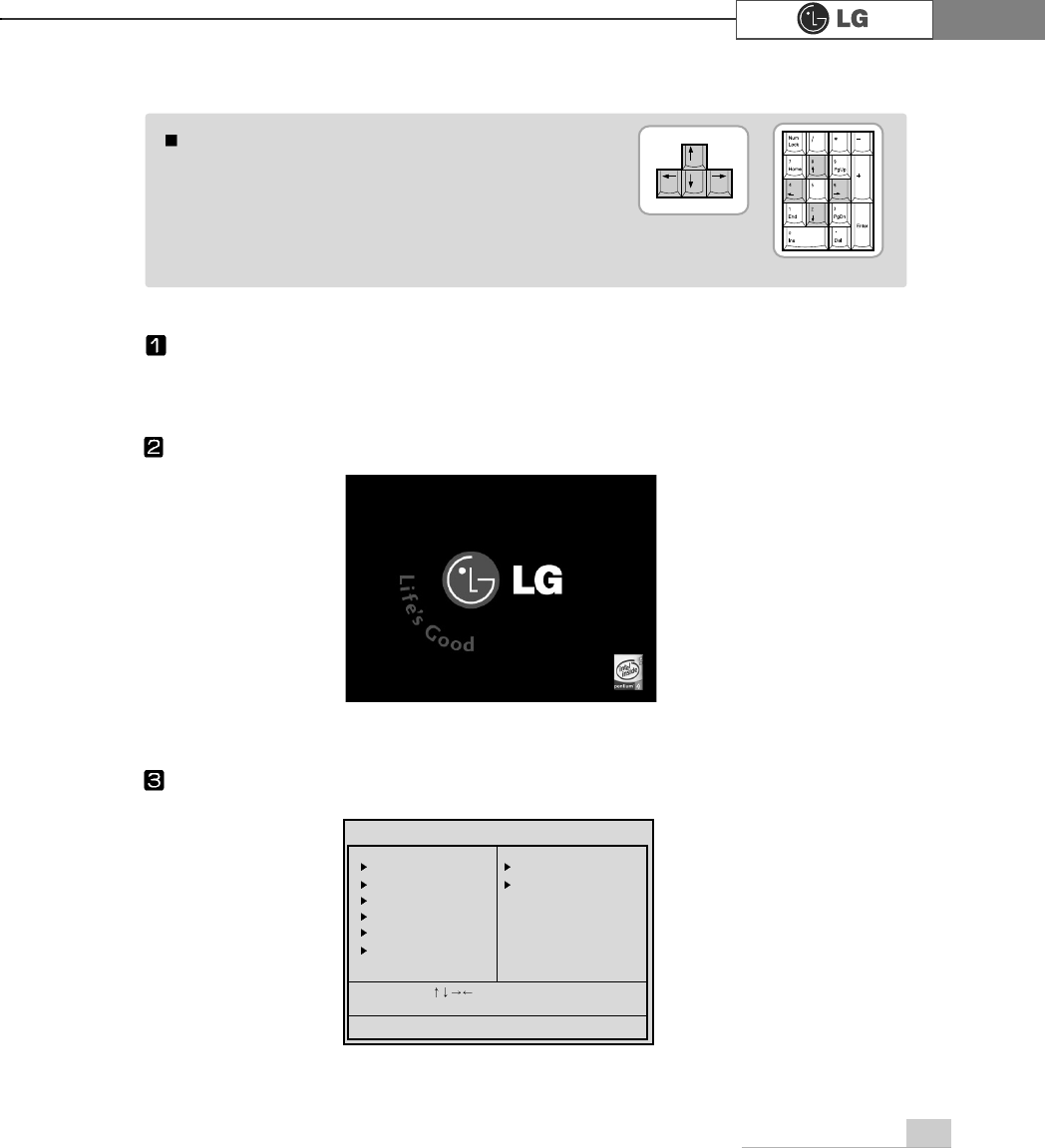
System setup 49
Turn on the computer and the monitor.
While the LG logo screen is on, press [Delete] key.
The initial setup screen will appear.
Cursor Pad
These keys are used to move the cursors on the
monitor screen up, down, right, and left.
When the Num Lock button is off on the numeric
keypad, the numeric keypad functions the same as
the cursor keypad.
Note
<Cursor Keypad>
<Numeric Keypad>
CMOS Setup Utility-Copyright(C)1984-2004 Award Software
Standard CMOS Features PC Health Status
Advanced BIOS Features Frequency/Voltage Control
Advanced Chipset Features Load Optimized Defaults
Integrated Peripherals Set Password
Power Management Setup Save & Exit Setup
PnP/PCI Configurations Exit Without Saving
Esc : Quit : Select ltem
F8: Q-Flash F10 : Save & Exit Setup
Virus Protection, Boot Sequence...
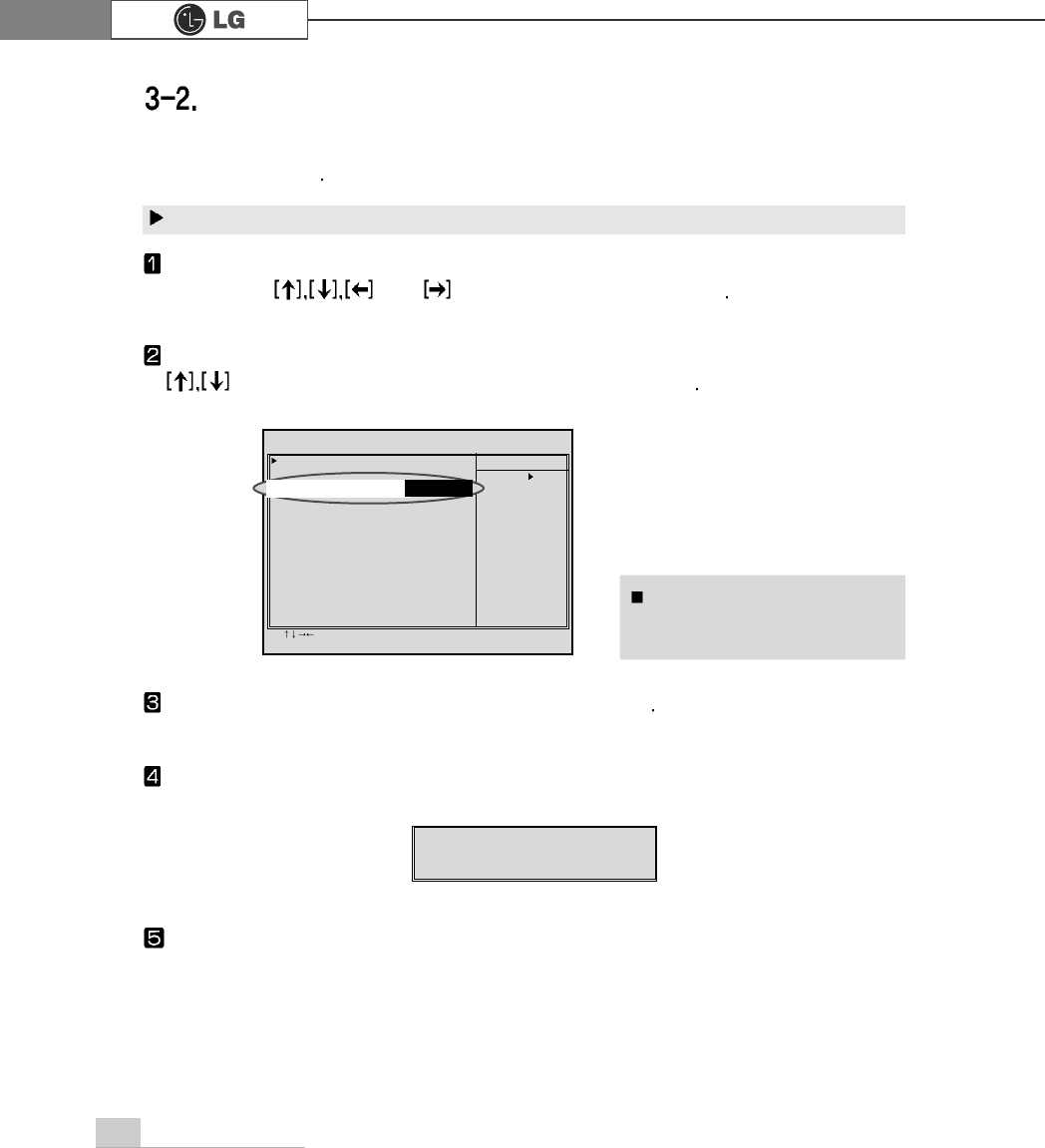
50 System setup
A booting with a USB device (USB-FDD, USB-ZIP, USB-CD-ROM, or USB-HDD)
proceeds as follows
When the following screen appears, select First Boot Device by pressing
keys. Then, select the device and press [Enter] key
To save changes in System Setup, press the [F10] key
The computer reboots by the selected device.
When the following message appears on the screen, press the [Enter] key to
restart the computer.
SAVE to CMOS and EXIT(Y/N)? Y
Execute the initial screen of System Setup, and select Advance Bios Features
by pressing , and keys. Then, press [Enter] key
Booting with a USB Drive
CMOS Setup Utility-Copyright(C)1984-2004 Award Software
Advanced BIOS Features
:Move Enter:Select +/-/PU/PD:Value F10:Save ESC:Exit F1:General Help
F5:Previous Values F7:Optimized Defaults
Hard Disk Boot Priority [Press Enter]
BIOS Flash Protection [Auto]
First Boot Device [CDROM]
Second Boot Device [USB-FDD]
Third Boot Device [Hard Disk]
Boot Up Floppy Seek [Disabled]
Boot Up Num-Loce [On]
Passward Check [System]
Interrupt Mode [APIC]
Boot to OS2 or DR-DOS [Disabled]
HDD S,M,A,R,T, Capability [Enabled]
CPU Hyper-Threading [Enabled]
Limit CPUID Max.to3 [Enabled]
Full Screen LOGO Show [Enabled]
Summary Screen Show [Disabled]
Item Help
Memu Level
Select Your Boot
Device Priority
Bootable devices will be dis-
played only when bootable
devices are equipped.
First Boot Device
USB-FDD
Booting with a USB-FDD, USB-ZIP, or USB-CD ROM
Note
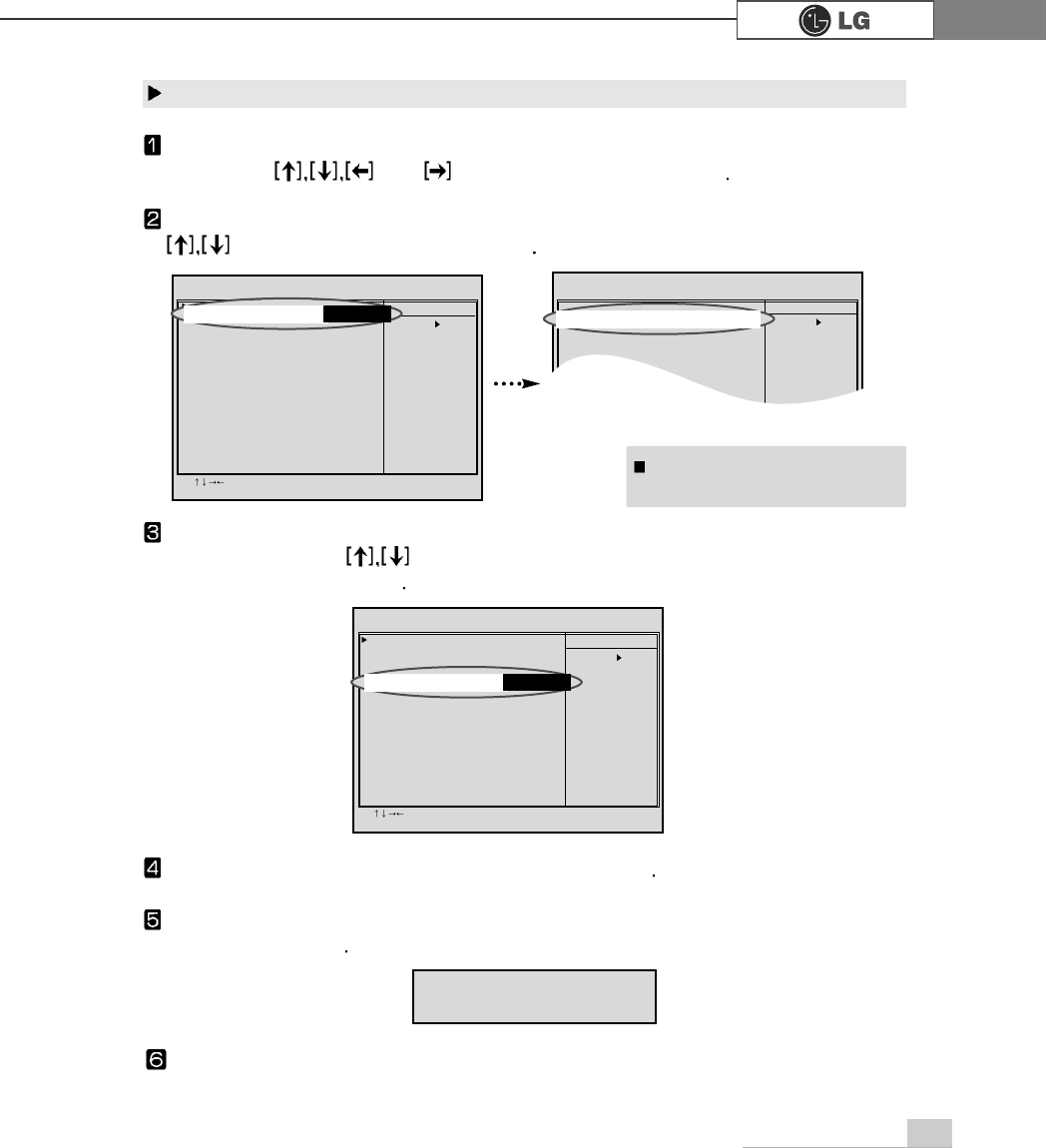
51System setup
When the following screen appears, select Hard Disk Boot priority by pressing
keys. Then, select the USB-HDD
Execute the initial screen of System Setup, and select Advance Bios Features
by pressing , and keys. Then, press [Enter] key
CMOS Setup Utility-Copyright(C)1984-2004 Award Software
Advanced BIOS Features
:Move Enter:Select +/-/PU/PD:Value F10:Save ESC:Exit F1:General Help
F5:Previous Values F7:Optimized Defaults
Hard Disk Boot Priority [Press Enter]
BIOS Flash Protection [Auto]
First Boot Device [CDROM]
Second Boot Device [USB-FDD]
Third Boot Device [Hard Disk]
Boot Up Floppy Seek [Disabled]
Boot Up Num-Loce [On]
Passward Check [System]
Interrupt Mode [APIC]
Boot to OS2 or DR-DOS [Disabled]
HDD S,M,A,R,T, Capability [Enabled]
CPU Hyper-Threading [Enabled]
Limit CPUID Max.to3 [Enabled]
Full Screen LOGO Show [Enabled]
Summary Screen Show [Disabled]
Item Help
Memu Level
Select Your Boot
Device Priority
Hard Disk Boot Priority [Press Enter]
CMOS Setup Utility-Copyright(C)1984-2004 Award Software
Advanced BIOS Features
:Move Enter:Select +/-/PU/PD:Value F10:Save ESC:Exit F1:General Help
F5:Previous Values F7:Optimized Defaults
Hard Disk Boot Priority [Press Enter]
BIOS Flash Protection [Auto]
First Boot Device [CDROM]
Second Boot Device [USB-FDD]
Third Boot Device [Hard Disk]
Boot Up Floppy Seek [Disabled]
Boot Up Num-Loce [On]
Passward Check [System]
Interrupt Mode [APIC]
Boot to OS2 or DR-DOS [Disabled]
HDD S,M,A,R,T, Capability [Enabled]
CPU Hyper-Threading [Enabled]
Limit CPUID Max.to3 [Enabled]
Full Screen LOGO Show [Enabled]
Summary Screen Show [Disabled]
Item Help
Memu Level
Select Your Boot
Device Priority
CMOS Setup Utility-Copyright(C)1984-2004 Award Software
Hard Disk Boot Priority
000
1. HDD
2. Cho M. :S_ATA1-XXXXXX
3. Bootable Add-in Cable
Item Help
Memu Level
To save changes in System Setup, press the [F10] key
The computer reboots by the selected device.
When the following message appears on the screen, press the [Enter] key to
restart the computer
SAVE to CMOS and EXIT(Y/N)? Y
When the following screen appears by pressing [ESC] key, select Third Boot
Device by pressing keys. Then, select the Hard Disk by pressing [Page
up] and [Page down]keys
Third Boot Device
Hard Disk
1. USB-HDD0:XX
A bootable device should be
installed to display the device.
Booting with a USB-HDD
Note
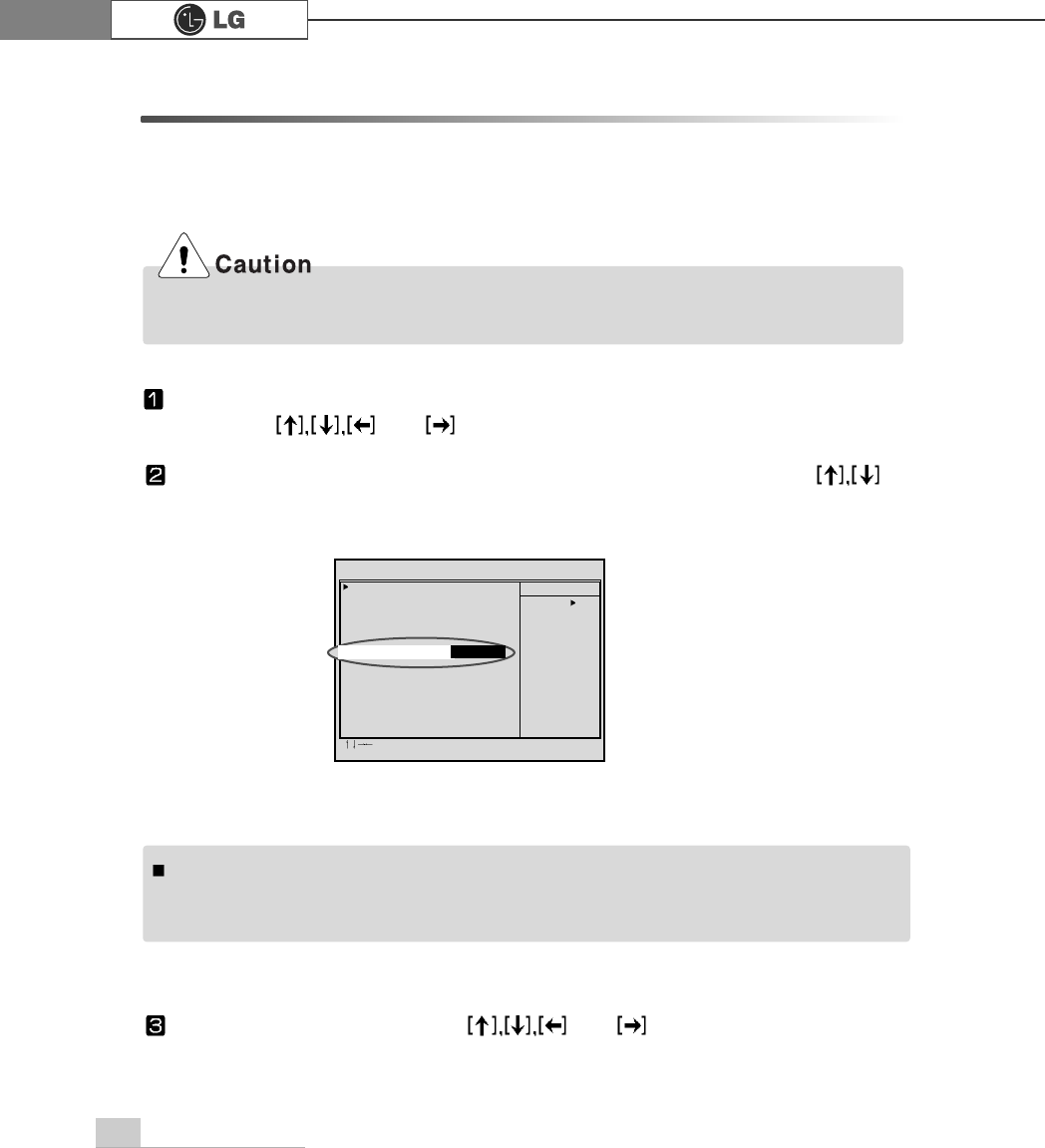
52 System setup
When the next screen appears, select Password Check by pressing
keys and the Setup or System by pressing the [Page Up] and [Page Down]
keys. Then, press [Enter] key.
Execute the initial screen of System Setup and select Advanced Bios Features
by pressing , and keys. Then, press [Enter] key.
Select Set Password by pressing , and keys on the initial setup
screen, and press [Enter].
3-3. Setting a Password
To prevent other users from changing computer settings, you can register a pass-
word. A password can be registered during booting or System Setup.
Without the registered password, if any, access to the system will be denied. Write down
and keep your password in a safe place.
You will be asked to input the password only when you select "Setup" in Security Option or when
you select "Setup" by pressing [Delete] key on the initial screen. The password protects the com-
puter by stopping others from changing computer settings and system setup.
Note
CMOS Setup Utility-Copyright(C)1984-2004 Award Software
Advanced BIOS Features
:Move Enter:Select +/-/PU/PD:Value F10:Save ESC:Exit F1:General Help
F5:Previous Values F7:Optimized Defaults
Hard Disk Boot Priority [Press Enter]
BIOS Flash Protection [Auto]
First Boot Device [CDROM]
Second Boot Device [USB-FDD]
Third Boot Device [Hard Disk]
Boot Up Floppy Seek [Disabled]
Boot Up Num-Loce [On]
Passward Check [System]
Interrupt Mode [APIC]
Boot to OS2 or DR-DOS [Disabled]
HDD S,M,A,R,T, Capability [Enabled]
CPU Hyper-Threading [Enabled]
Limit CPUID Max.to3 [Enabled]
Full Screen LOGO Show [Enabled]
Summary Screen Show [Disabled]
Item Help
Memu Level
Select Your Boot
Device Priority
Passward Check Setup
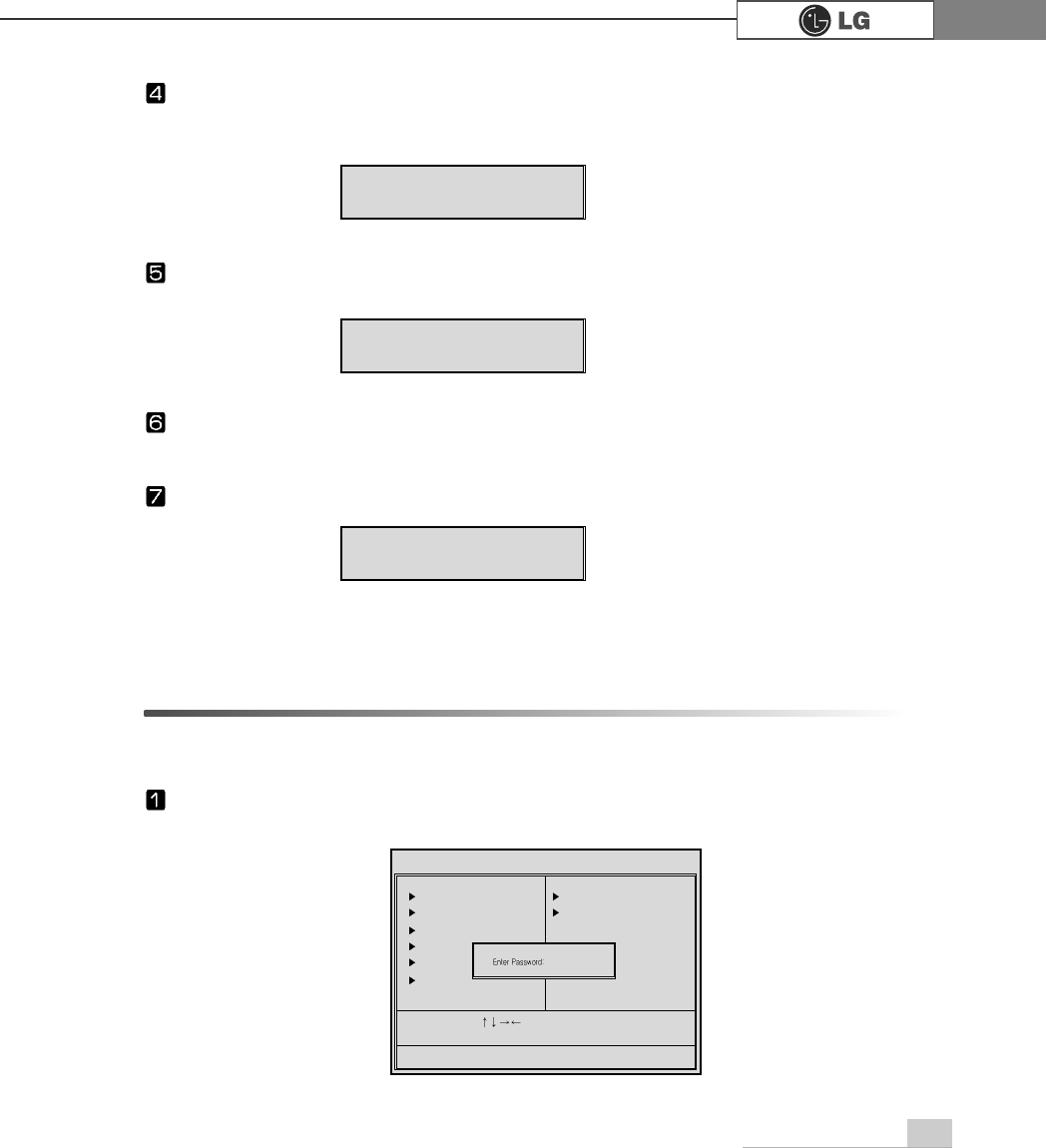
53System setup
3-4. Deleting or Changing a Password
You can delete or change the password only after inputting the current password.
Execute the initial screen of System Setup, enter the password, and press the
[Enter] key.
When asked to confirm the password, input the password again and press [Enter]
key.
To save changes in System Setup, press [F10].
When the following message appears, press [Enter] key to restart the computer.
When the following message appears on the screen, input the password and
press [Enter] key. The password must be alphanumeric and not exceed eight
digits.
SAVE to CMOS and EXIT(Y/N)? Y
Confirm Password :
Enter Password :
CMOS Setup Utility-Copyright(C)1984-2004 Award Software
Standard CMOS Features PC Health Status
Advanced BIOS Features Frequency/Voltage Control
Advanced Chipset Features Load Optimized Defaults
Integrated Peripherals Set Password
Power Management Setup Save & Exit Setup
PnP/PCI Configurations Exit Without Saving
Esc : Quit : Select ltem
F8: Q-Flash F10 : Save & Exit Setup
Virus Protection, Boot Sequence...
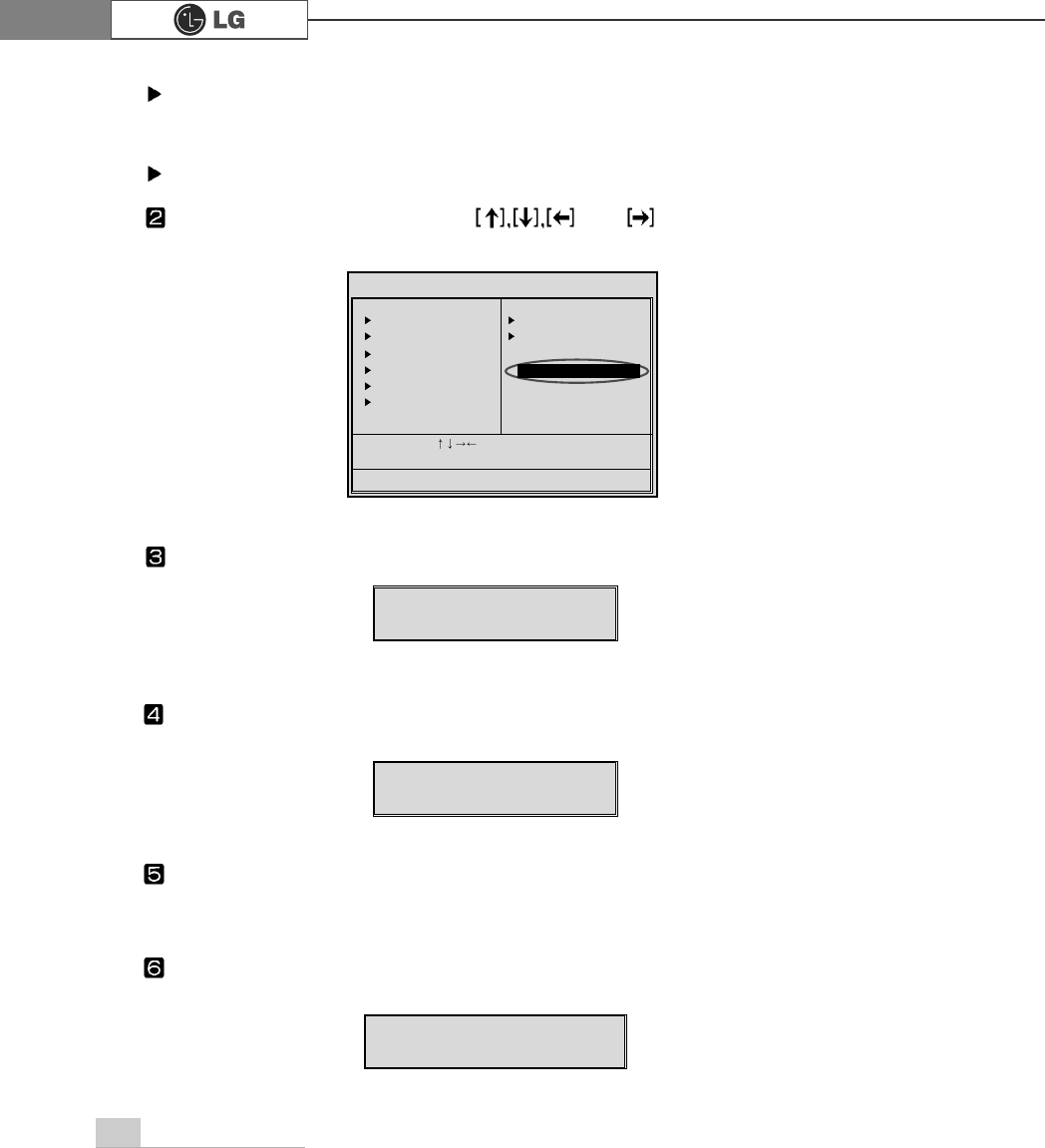
54 System setup
Changing the Password
Change the password in the same procedure as that of password setting.
Deleting the Password
Select Set Password by pressing , and keys on the initial screen
of the Setup menu, and press the [Enter] key.
When the following message appears, press the [Enter] key.
A message will appear saying that the password has been deleted.
Press the [Enter] key.
To save the change in System Setup, press the [F10].
When the following message appears on the screen, press the [Y] key and the
[Enter] key. Then, the computer will restart.
PASSWORD DISABLD!!!
Press any key to continue...
Enter Password :
SAVE to CMOS and EXIT(Y/N)? Y
CMOS Setup Utility-Copyright(C)1984-2004 Award Software
Standard CMOS Features PC Health Status
Advanced BIOS Features Frequency/Voltage Control
Advanced Chipset Features Load Optimized Defaults
Integrated Peripherals Set Password
Power Management Setup Save & Exit Setup
PnP/PCI Configurations Exit Without Saving
Esc : Quit : Select ltem
F8: Q-Flash F10 : Save & Exit Setup
Virus Protection, Boot Sequence...
Set Password

55System setup
3-5. Initializing System Setup
If you changed the system setup by mistake, it can be recovered to the default set-
ting.
Execute the initial screen of System Setup, and select the Load Optimized
Defaults item by pressing arrow keys. Then, press [Enter].
When the following message appears on the screen, press [Y] and [Enter].
System setup will be return to the factory setting.
To save the change in System Setup, press [F10].
When the following message appears, press the [Enter] key to restart the com-
puter.
SAVE to CMOS and EXIT(Y/N)? Y
Load Optimized Defaults (Y/N) ? Y
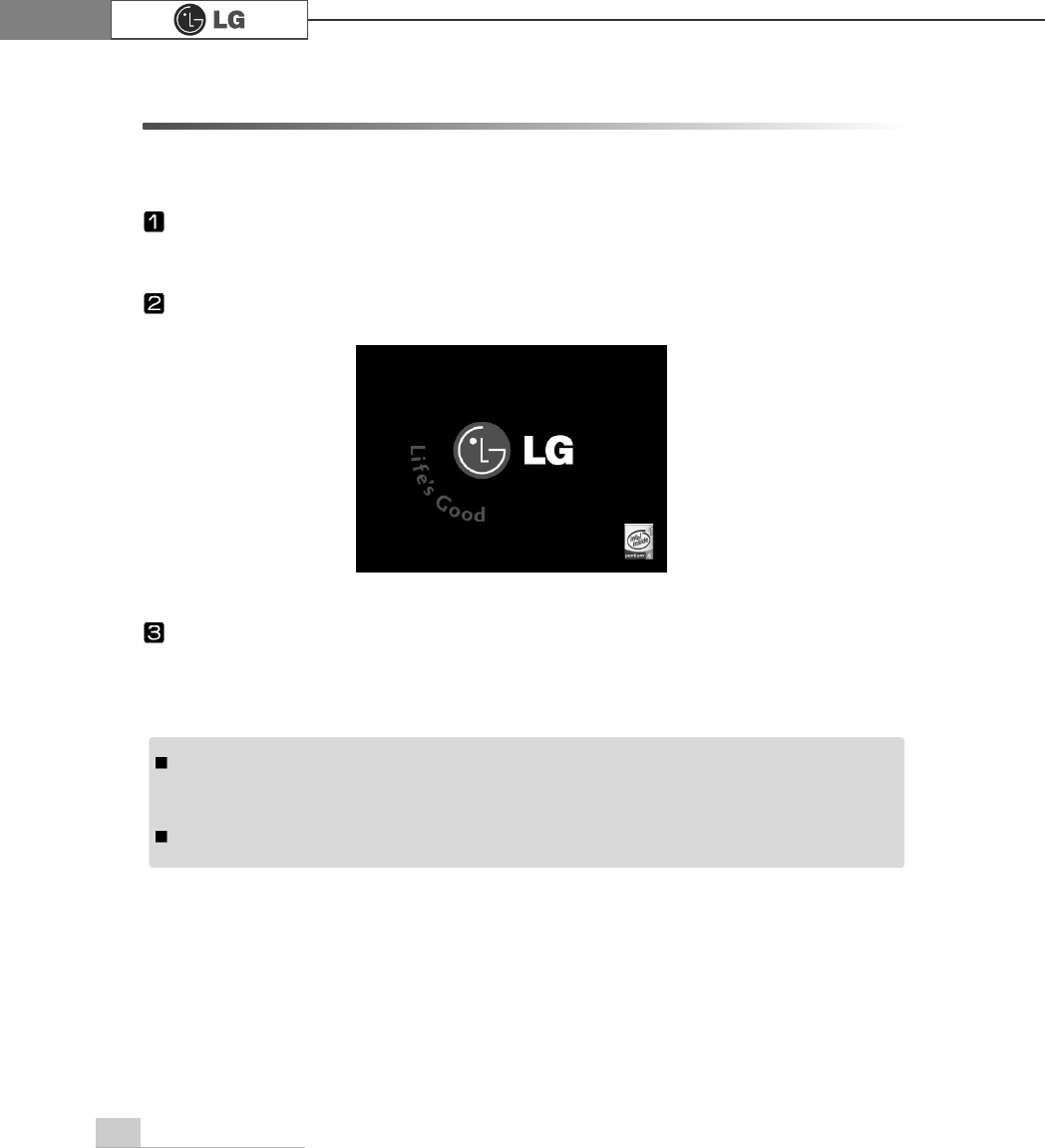
56 System setup
The following instruction explains a way to decide the temporary booting orders with-
out affecting CMO setup.
3-6. Deciding the Temporary Booting Orders
Turn on the computer and the monitor.
Selected device from the Boot menu will start the system.
While LG logo screen is on, press [F12].
The menus may differ by product model : USB-FDD, USB-ZIP, USB-HDD, and USB-CD-
ROM. Bootable devices will be displayed only when they are equipped in before turning
the computer on.
USB-HDD can be found from the Hard disk menu.
Note
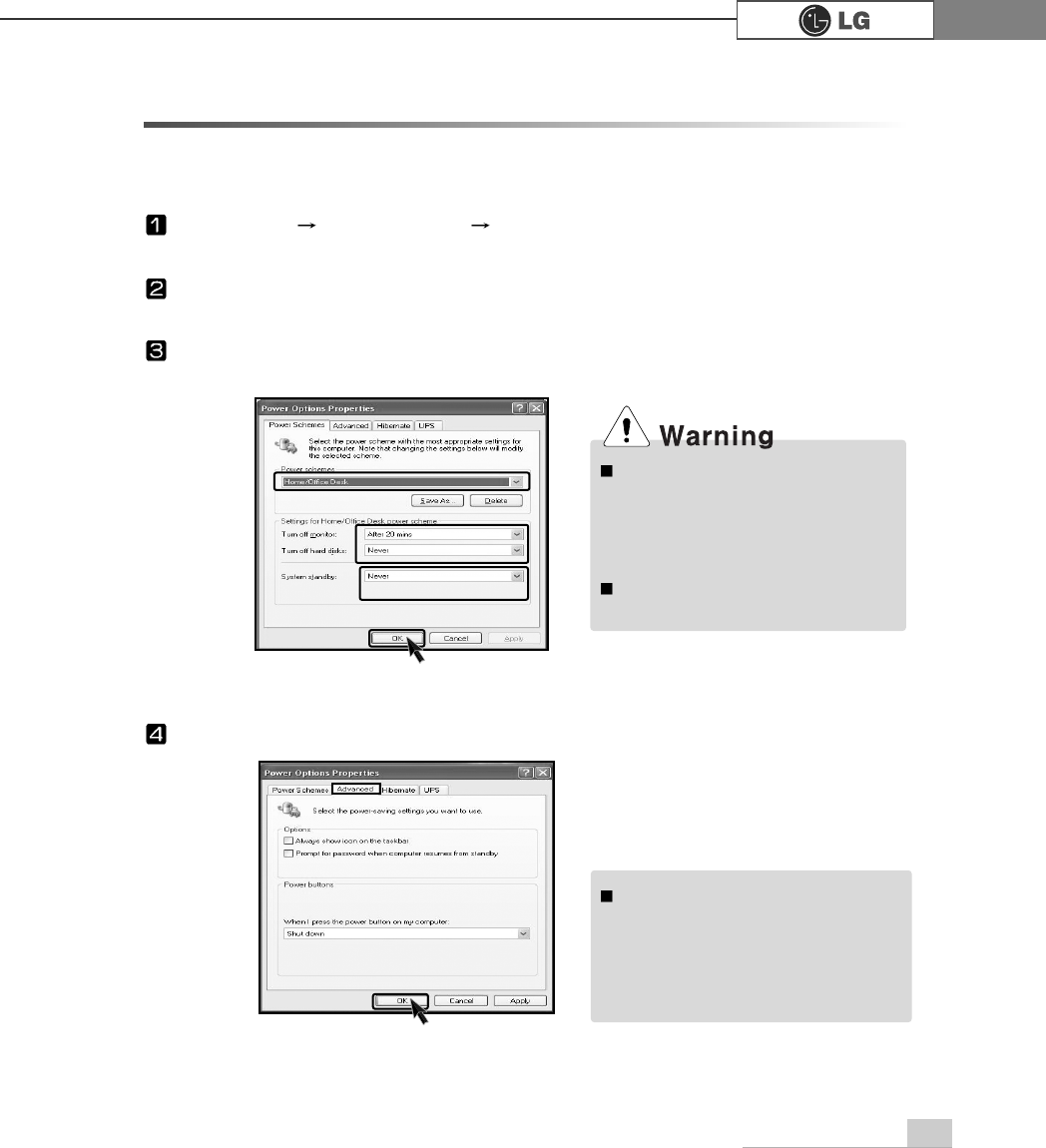
57System setup
Regardless of BIOS setup, you can use the Power Saver mode in Windows as fol-
lows.
3-7. Setting the Power Saver Mode
Press the advanced tab and set options appropriately. Then, click the [OK] button.
After setting Power Scheme items in the Power Schemes tab, click the [OK]
button.
Select [Start] [Control Panel] [Switch to Classic View].
Double-click the Power option icon on the Control Panel window.
TWhen the device connected to
the computer does not support
Power Saver functions, the
Standby mode or Hibernate mode
may not be properly function.
In this case, deactivate Power
Saver feature.
Hibernate Mode :The current
work states are saved intact on the
H/D before the power goes off.
The states will be recovered as
they were when the power is on
later.
Note
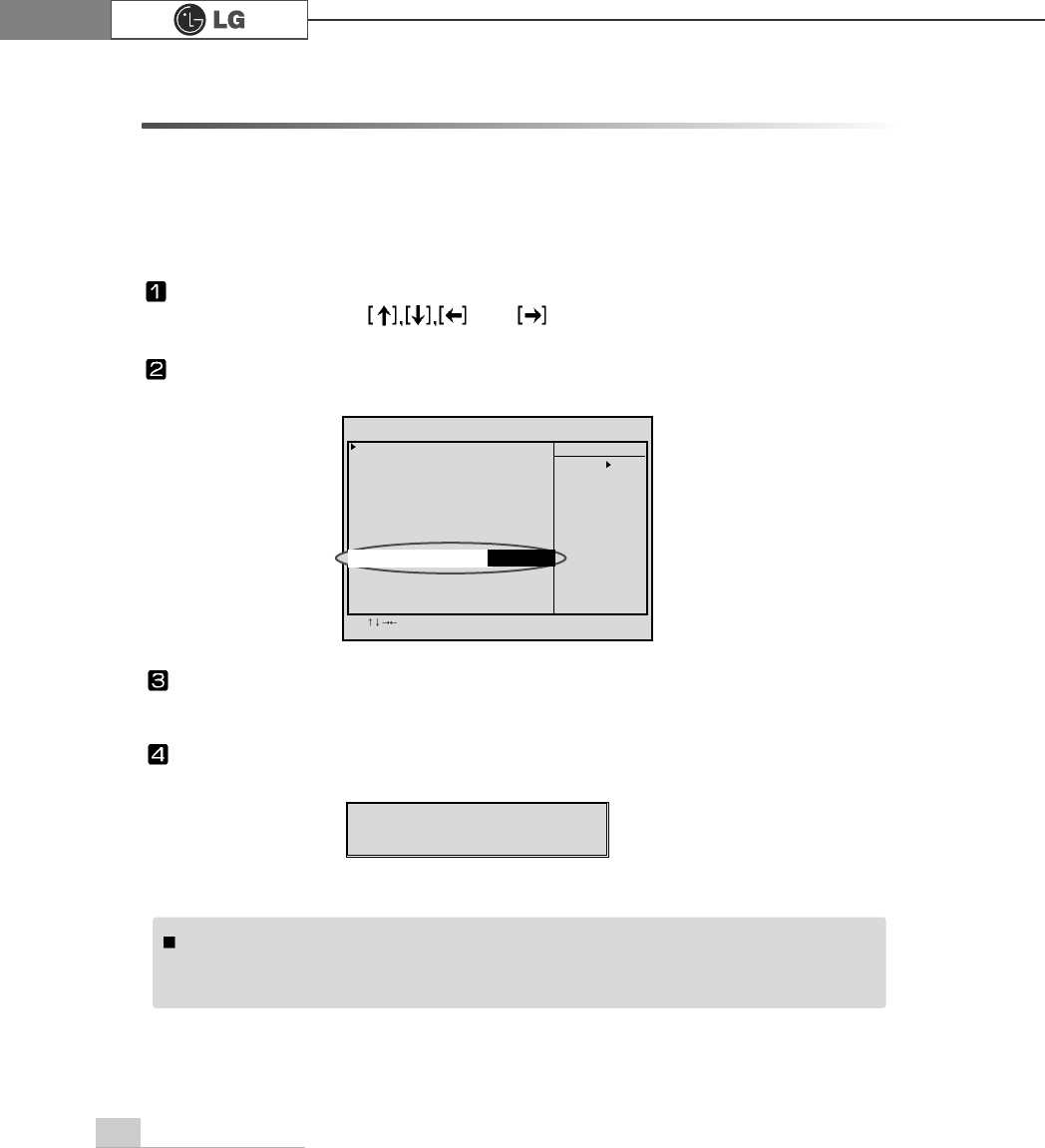
58 System setup
The Hyper-threading feature improves the performance of the CPU greatly as if
two CPUs were running. This feature is especially efficient for multimedia tasks
such as games and graphic jobs. Hyper-threading is supported only by the CPU
with Hyper-Threading (HT) feature. Check the "Intel" sticker on the side of the
computer to see if the CPU supports hyper-threading.
3-8. Using Hyper-Threading Feature
Execute the initial screen of System Setup, and select Advanced Bios
Features by pressing , and keys. Then, press the [Enter] key.
When the following screen appears, select Hyper-Threading Technology and
Enabled.
To save changes in System Setup, press [F10].
When the following message appears, press the [Enter] key to restart the com-
puter.
SAVE to CMOS and EXIT(Y/N)? Y
Hyper-threading is supported only by Windows XP. If you execute software or games
that does not support hyper-threading, an error may occur. When this happens, disable
the "Hyper-Threading Technology" featuree.
Note
CMOS Setup Utility-Copyright(C)1984-2004 Award Software
Advanced BIOS Features
:Move Enter:Select +/-/PU/PD:Value F10:Save ESC:Exit F1:General Help
F5:Previous Values F7:Optimized Defaults
Hard Disk Boot Priority [Press Enter]
BIOS Flash Protection [Auto]
First Boot Device [CDROM]
Second Boot Device [USB-FDD]
Third Boot Device [Hard Disk]
Boot Up Floppy Seek [Disabled]
Boot Up Num-Loce [On]
Passward Check [System]
Interrupt Mode [APIC]
Boot to OS2 or DR-DOS [Disabled]
HDD S,M,A,R,T, Capability [Enabled]
CPU Hyper-Threading [Enabled]
Limit CPUID Max.to3 [Enabled]
Full Screen LOGO Show [Enabled]
Summary Screen Show [Disabled]
Item Help
Memu Level
Select Your Boot
Device Priority
CPU Hyper-Threading
Enabled

59MEMO
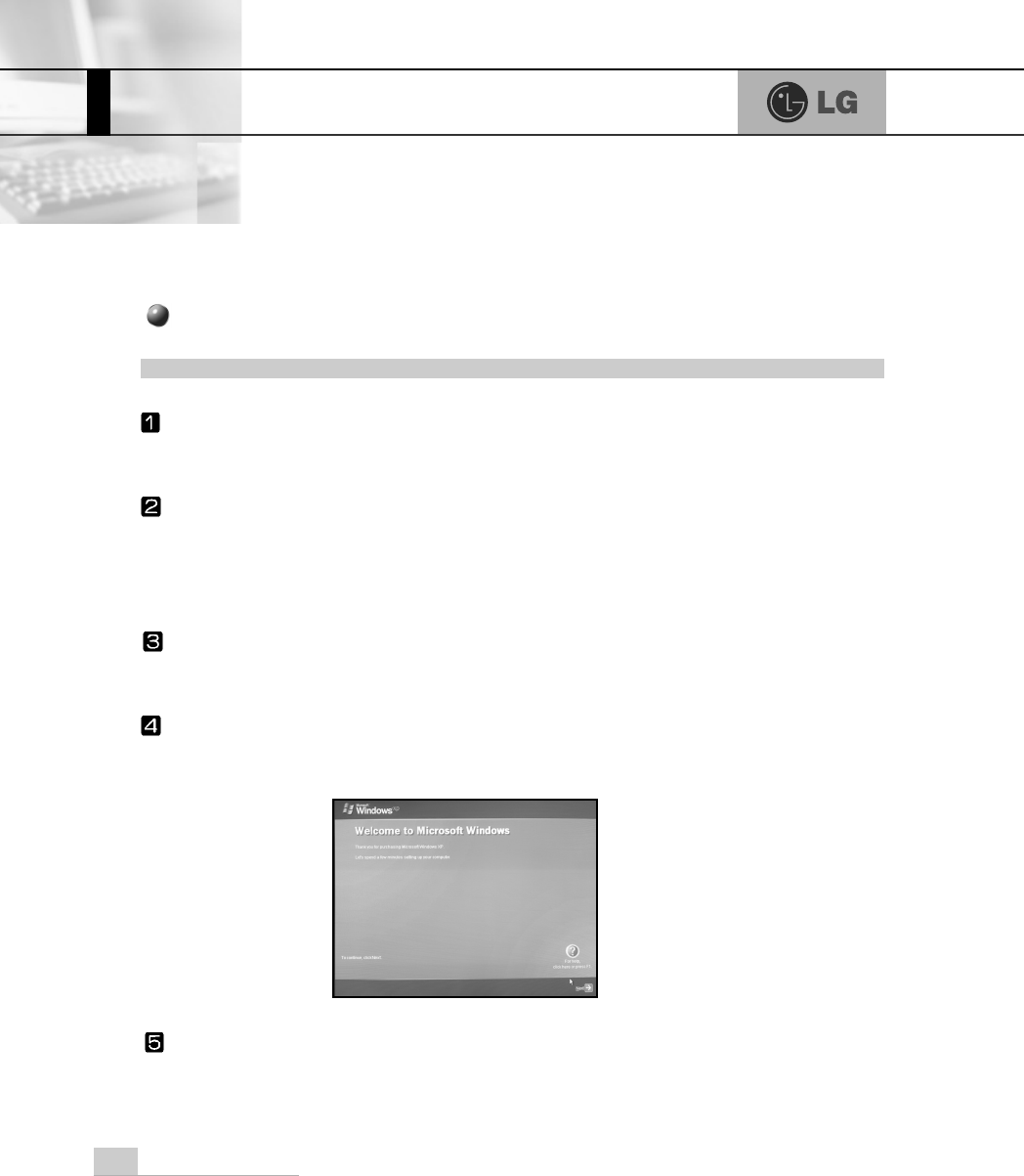
System Recovery
60
You can restore the system in two ways depending on the current status of the sys-
tem. However, to restore the hard disk, you need to back up necessary software
and data files in advance. After completing Windows installation, you need to regis-
ter the User Properties when booting the system as if you did your new computer.
4.System Recovery
Back up the data stored in the computer.
Insert the Restore CD in the CD-ROM drive. When "Press any key to boot
from CD..." message appears on the screen, press the [Enter] key.
Continue installation by following instructions on the screen.
After completing installation of Windows, remove the CD and restart the sys-
tem. When the following screen appears, register the User Properties according
to instructions on the screen.
Installation with Recovery CD
Installation
After the Windows operating system installation is complete, install the LG GILJABI
CD (software installation CD) on your computer, and then you can use all application
programs and device drivers.
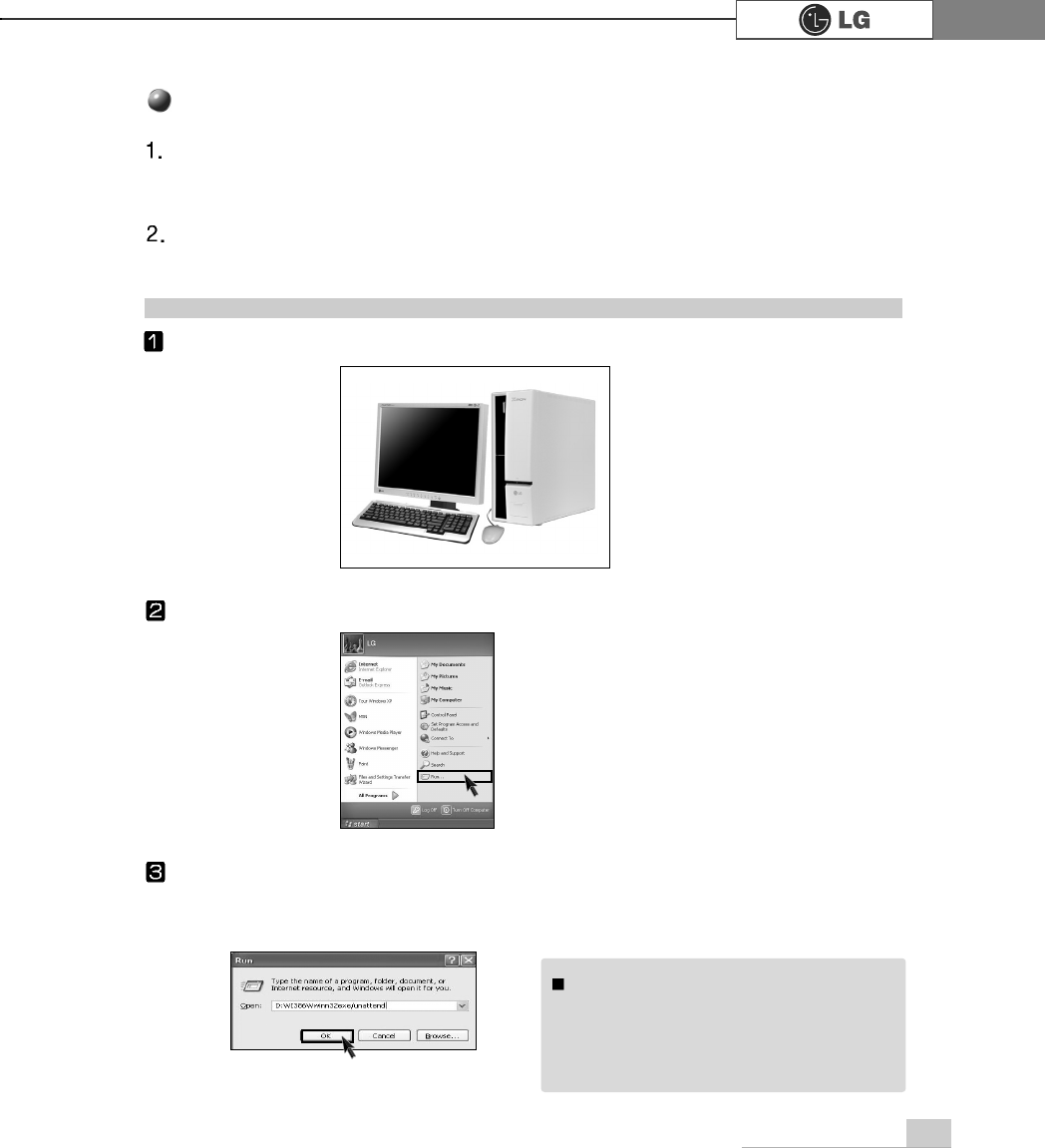
System Recovery 61
For Windows users
If Windows XP is already installed on the hard disk, you can upgrade existing
Windows XP without formatting the hard disk
In the case that Windows XP is already running on the hard disk, upgrade
Windows XP as follows.
Click the [Start] and [Run] button.
Insert the Restore CD, and input D:\i386\winnt32.exe/unattend. Then, click the
[OK] button. (When the CD-ROM drive is D drive.)
Turn on the system where Windows XP is installed.
Installation of Windows XP Upgrade
To execute "winnt32.exe" without using
"Unattend" option, you must input the
product key attached on the computer.
You also need to have the computer
certified within 30 days after this.
Note
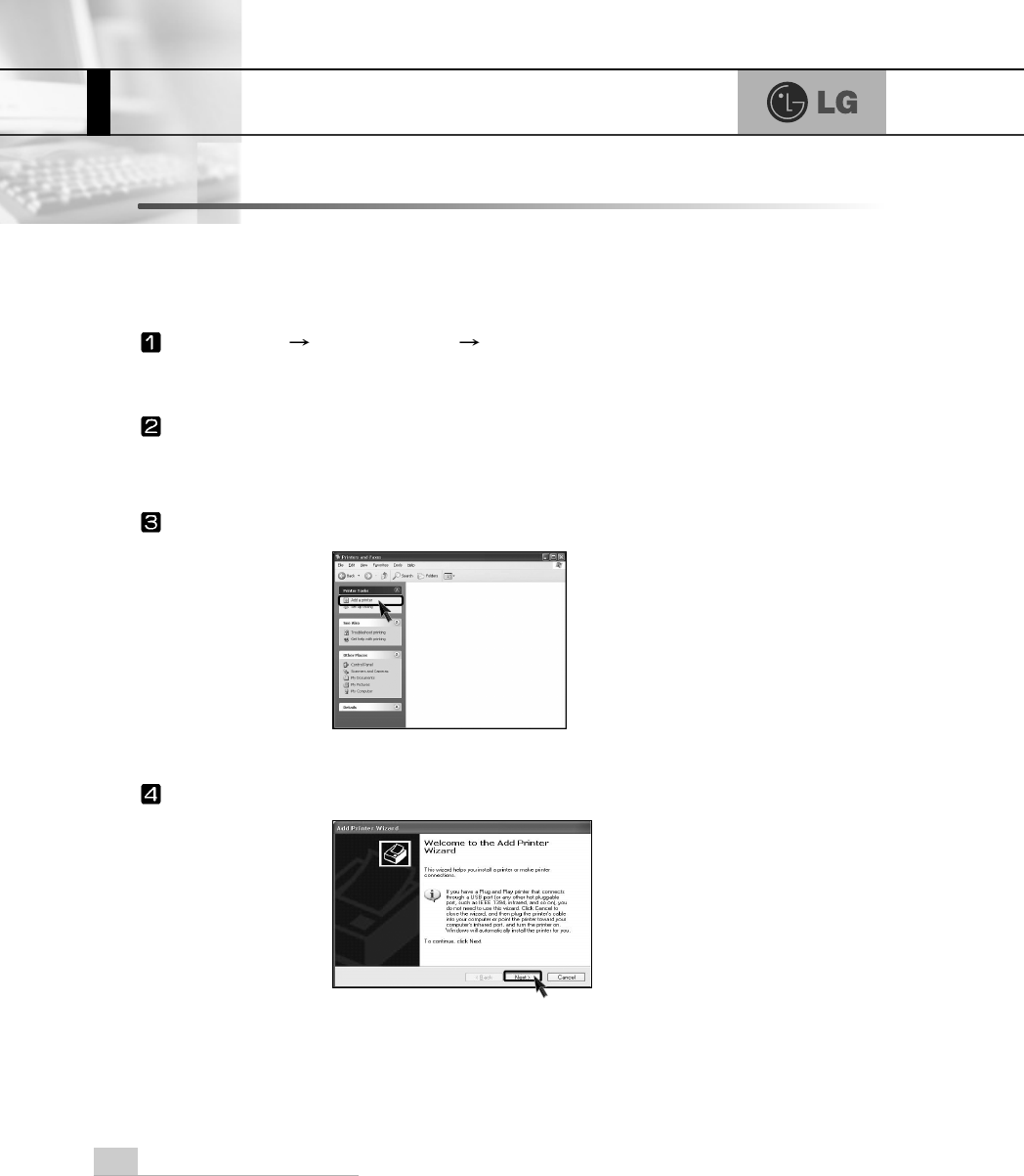
5. Reinstallation of Drivers
62 Reinstallation of Drivers
You must install the printer driver after connecting the printer. Windows XP can
automatically detect printer drivers. However, if Windows XP does not detect your
printer driver, install the printer driver as follows.
5-1.Reinstalling Printer Driver
Double click the [Printer and Fax] on the Control Panel window.
When the following screen appears, click the [Add Printer] button.
Select [Start] [Control Panel] [Class Desktop].
When the Add Printer Wizard appears, click the [Next] button.
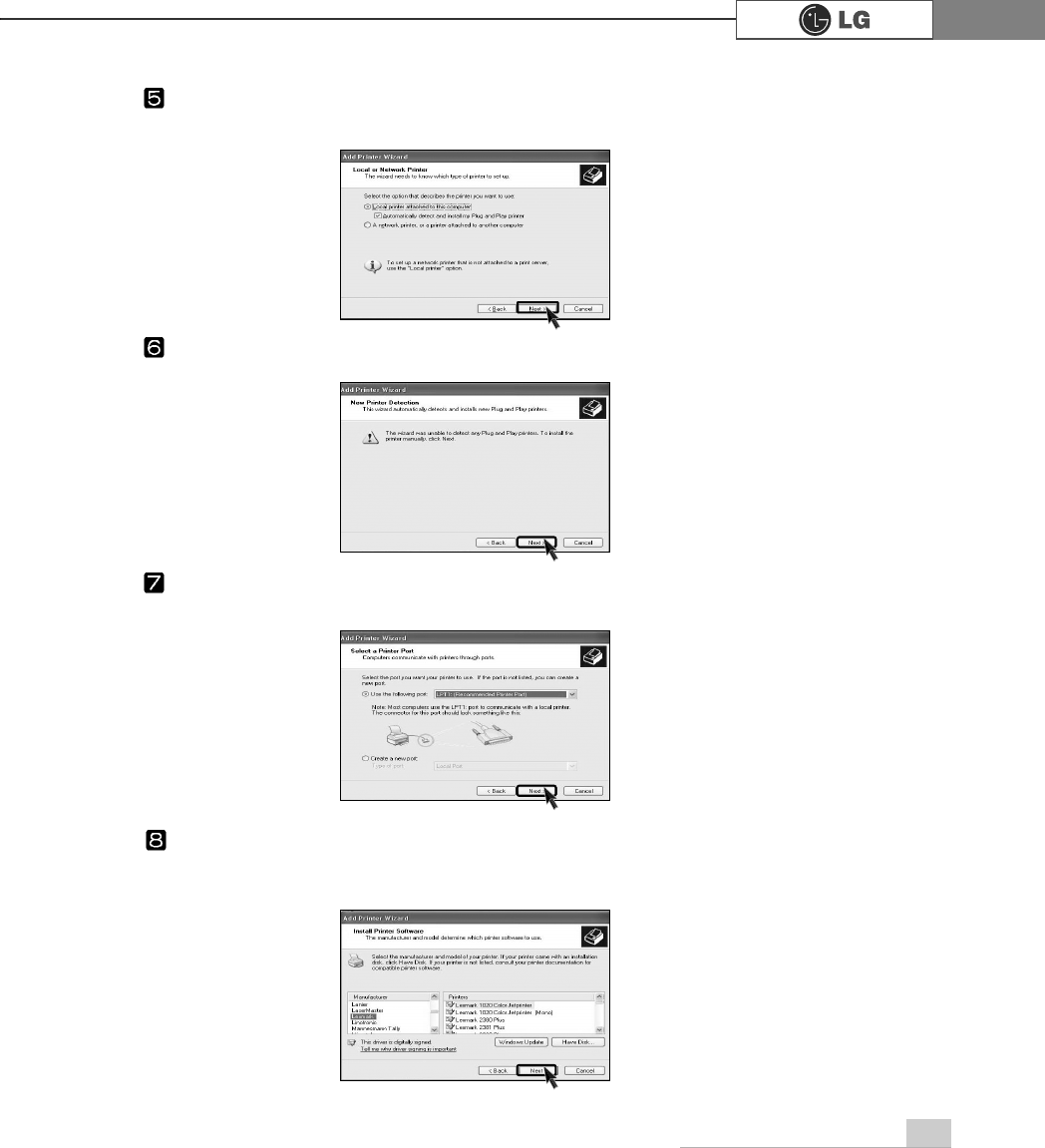
63Reinstallation of Drivers
When the following screen appears, check the connection type of the printer -
local or network. Then, select a printer and click the [Next] button.
New Printer Detection screen will appear. Click the [Next] button.
When Set Printer Port screen appears, select LPT1 or LPT2 before clicking the
[Next] button.
Select the manufacturer and model of your printer on the Select Printer screen.
If your printer came with an installation disk, click [Have Disk]. If not, just click
the [Next] button.
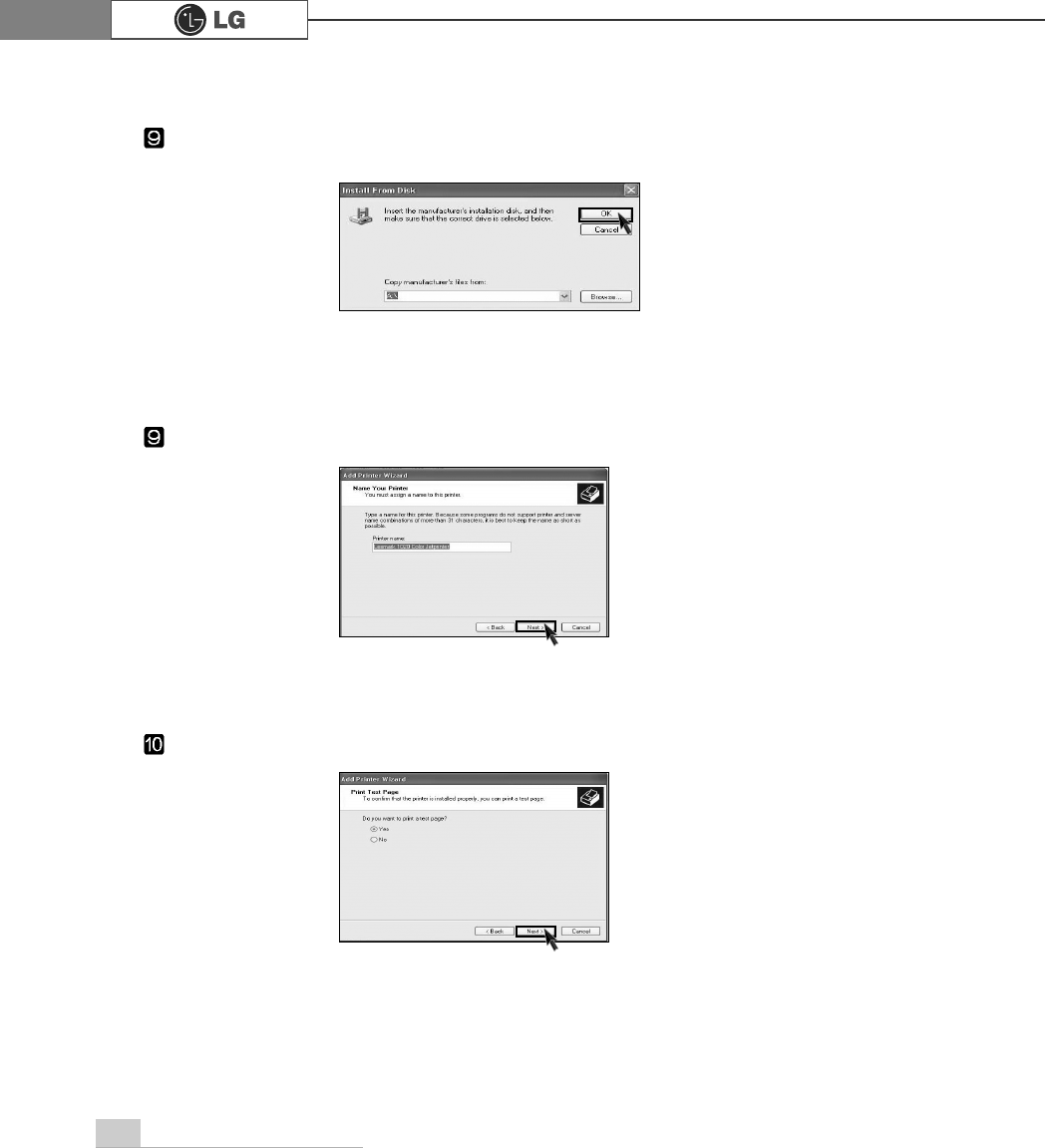
64 Reinstallation of Drivers
When Print Test Page screen appears, click the [Yes] and [Next].
Insert the diskette or driver CD in the driver and click the [OK] button.
Name the printer, and click the [Next] button.
When [Have Disk] is selected.
When [Next] is selected
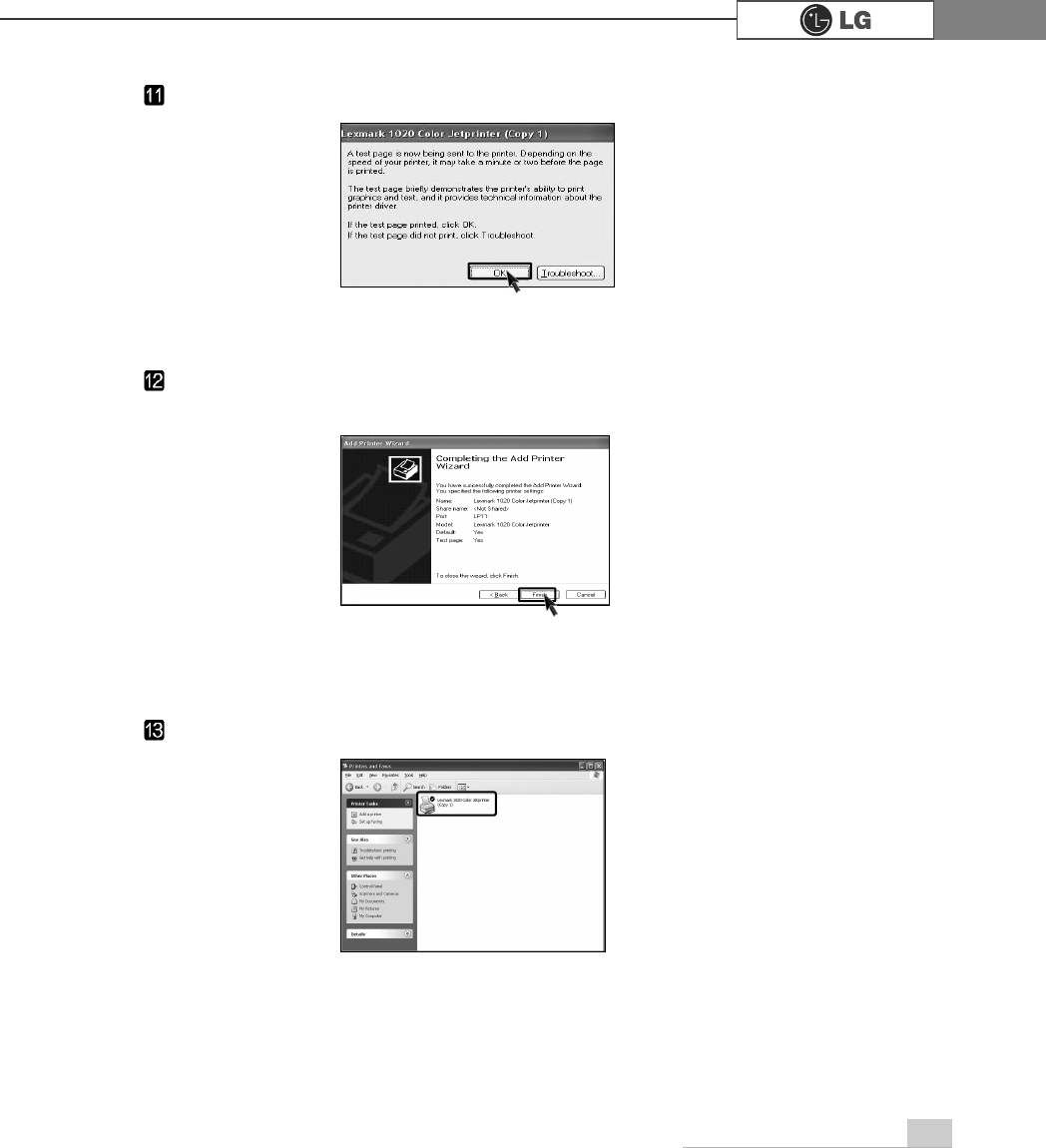
65Reinstallation of Drivers
After the test page is properly printed out, click the [OK] button.
When the following screen appears, check the printer and click the [Finish]
button.
Now, the printer has been added. .
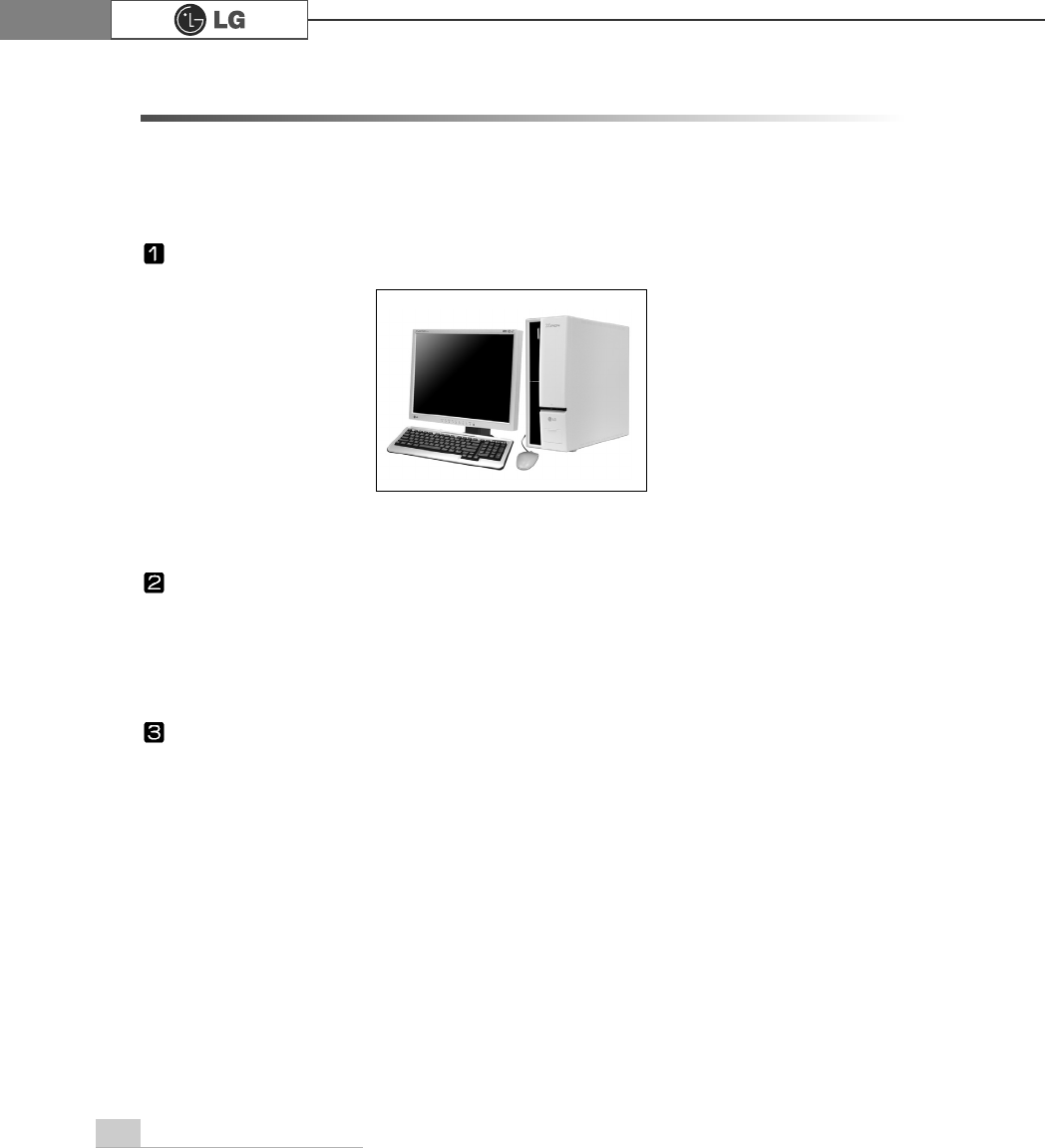
66 Reinstallation of Drivers
You must install a sound driver to listen to music files and CDs on the computer. A
sound driver basically comes out with the computer. If it has to be reinstalled,
however, follow the process below.
5-2.Reinstalling Sound Driver
Turn on the computer and the monitor.
Insert LG GILJABI CD in the CD-ROM driver. Select the sound driver to install
from the list.
The driver installation process will start. Follow instructions on the screen.
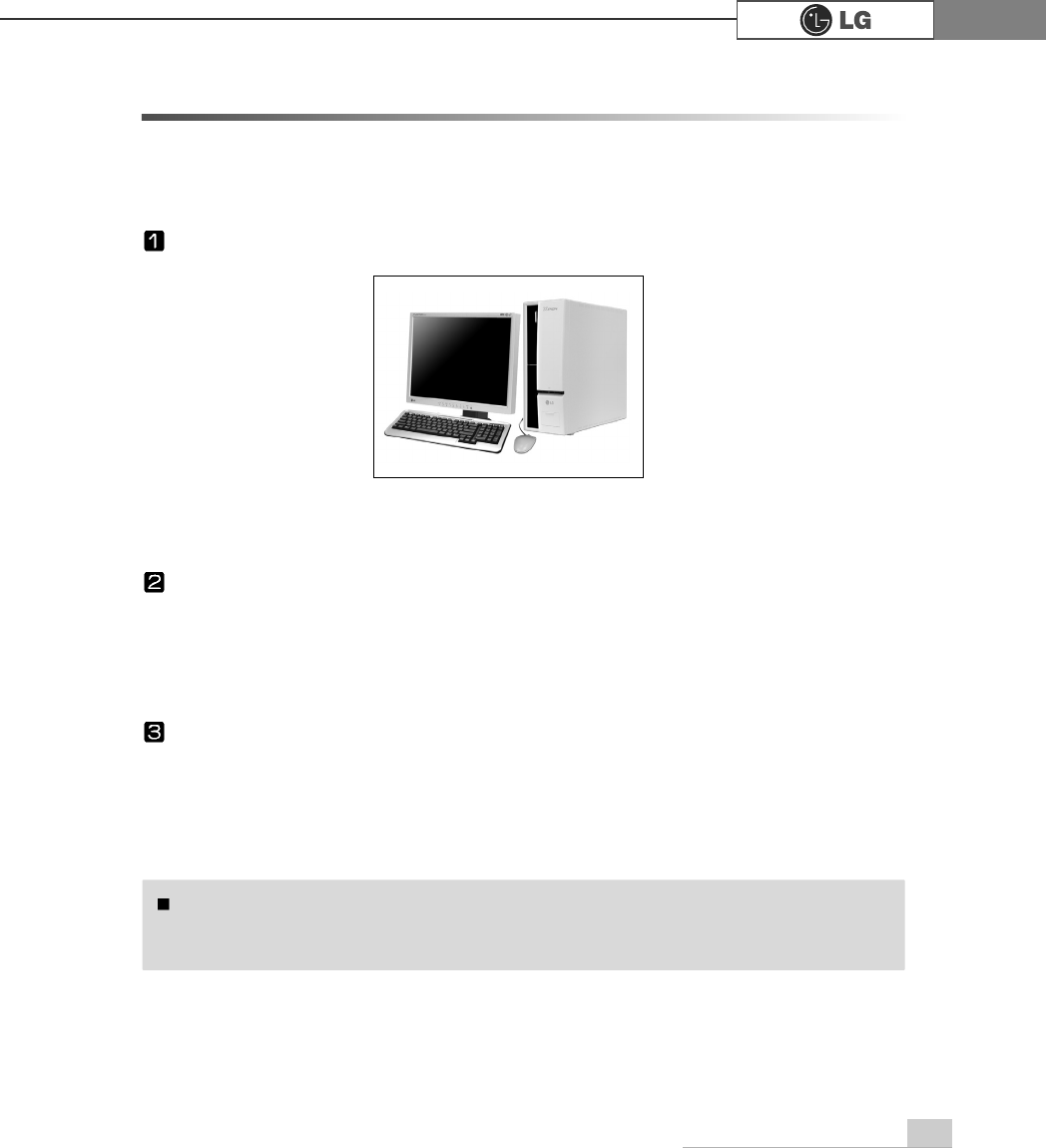
67Reinstallation of Drivers
The video driver displays on the monitor data stored on the computer. The video
driver is included in basic specification of the computer. However, in the case that
it is necessary to reinstall the video driver, carry out the following process.
5-3.Reinstalling Video Driver
Turn on the computer and the monitor.
Insert LG GILJABI CD in the CD-ROM driver. Select the video driver to install
from the list.
The driver installation process will start. Follow instructions on the screen.
When the computer uses the Intel Onboard Video, some games and programs that does
not support Screen Rotation may not be executed on the screen. When this happens,
disable the Screen Rotation.
Note
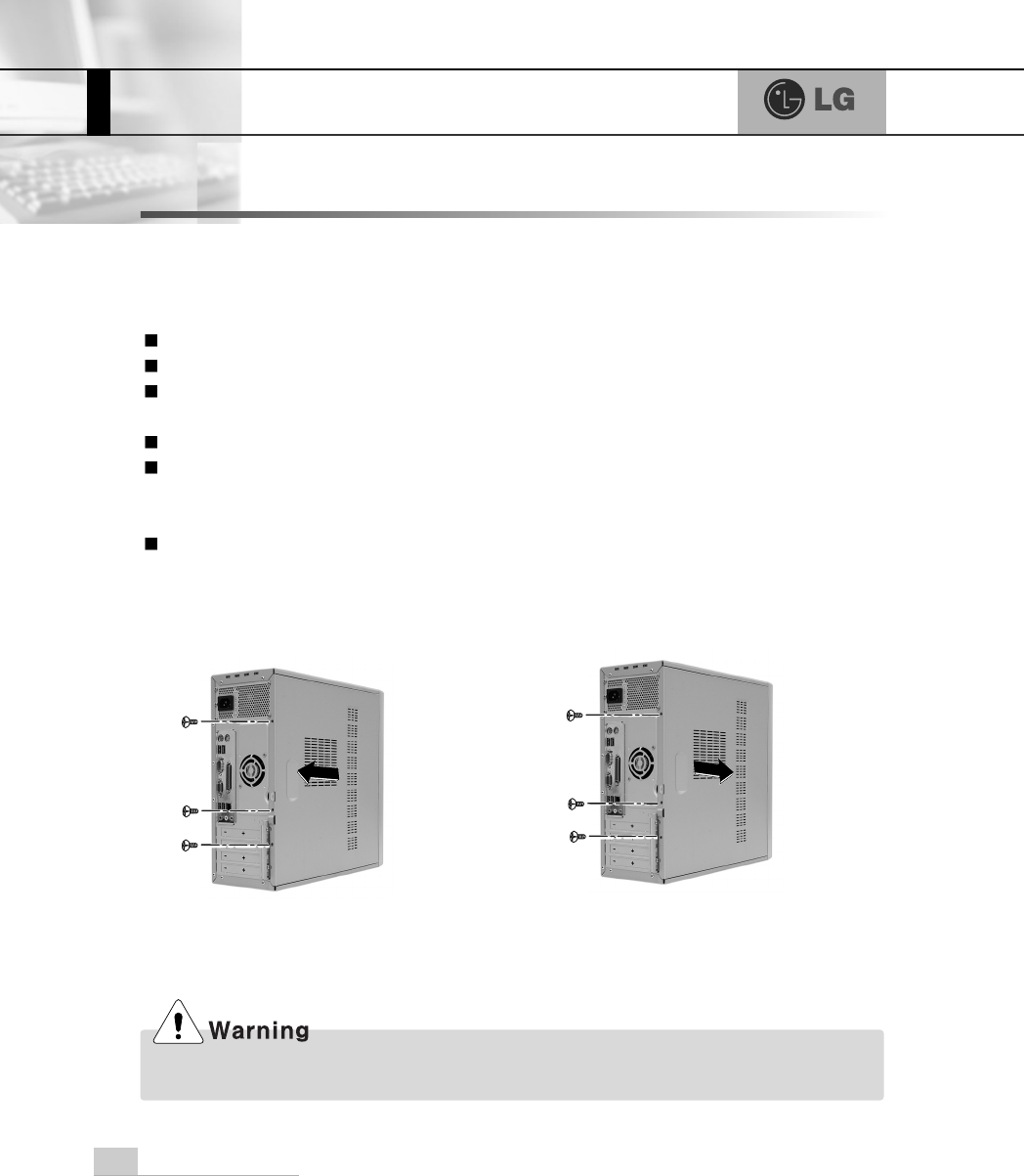
System Expansion
68
6-1. Opening the computer case
Always consult with your service representatives before opening the computer case.
Note the following when opening the computer cover.
Opening the computer cover Closing the computer cover
Quit all programs in use.
Turn off the computer and the monitor before disconnecting the power.
Keep magnetic tools (for example, drivers) away from the computer since parts
inside the computer are electrically charged and sensitive to magnetic force.
Install the computer in a clean, easily-accessible place.
A small electric shock inside the computer may cause operational problems.
Before touching the computer, put hands on an unpainted metallic surface for two
or three seconds to remove static electricity before opening the cover.
When disassembling the computer, wear gloves to protect internal parts of the
computer and slot cards from damage.
6.System Expansion
Before assembling the computer cover, check if there is any metallic material left inside the
main body. A metallic substance inside the main body can cause an electric shock or fire.
Remove 3 screws from the cover and
then push the cover as the direction of
the arrow.
Push the cover in the direction of
arrow as it aligns the groove of com-
puter cover with body shown on the
picture and fasten 3 screws.